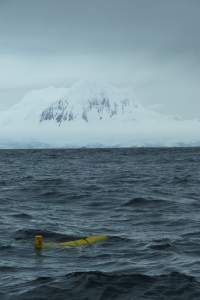It takes a week to get to the bottom of the earth. After three months of pining for Travis, five months of anticipation, and seemingly forty-seven different visits to sporting goods stores, I was ready to go. The day after Christmas I set off on my expedition. I flew St. Louis, Miami, Santiago, to Punta Arenas, Chile. A quick, very windy, day and half of getting issued gear and exploring pass and we board the boat—the Laurence M. Gould. The LMG is the ice strengthened research vessel that transports us all down to Palmer Station and then carries on floating around the peninsula on the Long Term Ecological Research cruise as it has for 20 years.


I see land!
Once on the ship I had a lot to learn. Starboard, Port, Aft, Hold, Bridge, Galley. The toilets are “heads”. My room was a “berthing van”. Besides being generally clueless amongst a team of scientists and shipmates, the journey brings other challenges. The four-day trip to Palmer through the Drake Passage is infamous for being a rocky ride. Everyone loads up on seasickness pills and patches and spends their days watching bad movies on couches that slide across the floor with every ship tilt and generally just tries not to vomit. I am proud to say I was among the hearty and barf-free.
Finally comes the day we arrive at Palmer. After days at sea, surrounded by only water and the occasional whale, penguin, or porpoise, I awake surrounded by giant ice mountains. Welcome to Antarctica. We’re like a tiny industrial intruder in secret blue alternate universe. The best description I’ve heard of the ice is “frozen windex” that is exactly what it looks like. I stood out on the bow hour hours as we slowly, tortuously approached station. And there it was, like a little coastal village, Palmer Station, Anvers Island, West Antarctic Peninsula 64W 64S. 

This is the darkest it gets here.
Palmer Station is a U.S. research base and it is nice. The deceptive blue corrugated steel exterior is a perfect cover for our relatively luxurious (as compared to my usual grad school life) inside existence. We have a bar, a gym, a lounge, arts and crafts, Frisbee golf, a sauna, a hot tub made out of a fishtank, and three meals and two snacks prepared for us everyday. What more could you possibly want? Myself and the other 41 people currently living here (some Raytheon staff, some scientists) have a community that works together, plays together, and runs like clockwork.
Don’t fret, your National Science Foundation tax dollars are put to good use. We don’t just sit around and play with penguins. We do work, really. As you can see from Travis’s links, there’s a lot to be done. While not reading about urban planning from my uninhabitable continent, I’m in the field, ie. the middle of the ocean. When we’re out there on a zodiac and the weather turns, being pelted by ice bullets and surrounded by 15 foot swells, let’s just say it’s… cold. You feel kinda like a badass, but mostly just cold.

Our fearless leader (Travis) weathering the storm on a glider deployment.

Back from a field trip, posing infront of an iceberg in the harbor.
Now that we’ve finally sat down to write this blog and gotten up to speed, stay tuned for more adventures from the life and times of Travis and Katie. We’ll try to keep it interesting.























